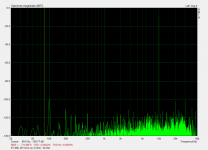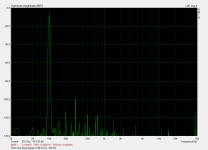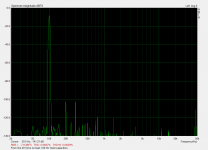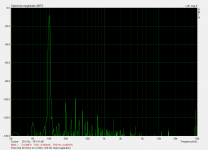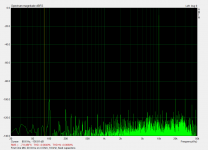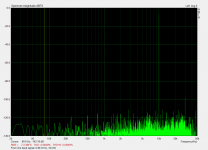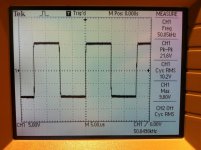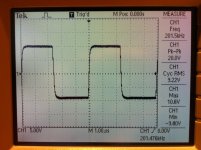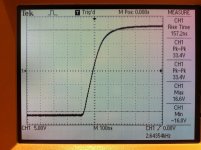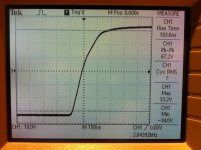Yes of course a new thread will be opened, very soon, just to finish the measurements on both prototype channels. 😉
What is this First One Amp module, any info? Is this your next project?
Yes new amp module named the First One, you could actually see it mounted on the heatsink on pic in post #3081. 😉
Yes new amp module named the First One, you could actually see it mounted on the heatsink on pic in post #3081. 😉
I like the circuit of VSSA can you post the circuit diagram of First One? A tentative one is fine with me.
Me wants First One badly! 😀
Do
Me too.
LC you promise me to publish your amp at end of this year. But I must wait for few days....
Hey! We must let LC work relaxed...he is perfectly free to reveal or not to reveal his new design.
He already did A LOT for the DIY community...for which we are indebted...
He already did A LOT for the DIY community...for which we are indebted...
How around 100Hz ?
Here are the requested plots of the First One amplifier, 34 ppm THD 100Hz at 100 Wrms/4 Ohm
1. Input signal 100 Hz
2. Output signal 20 Vrms, no load
3. Output signal 20 Vrms on 4 Ohm
Attachments
Now these 10 kHz plots and previous 100 Hz plots both series made today with fixed compensation SMD capacitors installed on PCB. Practically it is impossible to find the combination set by trimmer capacitors, but anyway very close results as before.
Plots of the First One amplifier, 40 ppm THD 10 kHz at 100 Wrms/4 Ohm
1. Input signal 10 kHz
2. Output signal 20 Vrms, no load
3. Output signal 20 Vrms on 4 Ohm
Plots of the First One amplifier, 40 ppm THD 10 kHz at 100 Wrms/4 Ohm
1. Input signal 10 kHz
2. Output signal 20 Vrms, no load
3. Output signal 20 Vrms on 4 Ohm
Attachments
100 W/4 Ohm from 100 Hz to 10 kHz THD changes from 34 to 40 ppm, only 6 ppm difference 😎
Now the square waves, slew rate, damping factor measurements will follow as well to define the output inductor.
I'm really enjoying holiday season in a company with the First One.
Now the square waves, slew rate, damping factor measurements will follow as well to define the output inductor.

I'm really enjoying holiday season in a company with the First One.

Here are the requested plots of the First One amplifier, 34 ppm THD 100Hz at 100 Wrms/4 Ohm

Happy New Year...!
Happy New Year Andrej...Well in half an hour!
Thanks so much for your great work...In my opinion, you are a true creative genius and I have not said that on a DIY forum ever before!
Really excited about 2014, my speakers, your amps and a drop dead gorgeous media server and WiFi DAC to feed them with lots and lots of music!
Cheers
Derek.
Happy New Year Andrej...Well in half an hour!
Thanks so much for your great work...In my opinion, you are a true creative genius and I have not said that on a DIY forum ever before!
Really excited about 2014, my speakers, your amps and a drop dead gorgeous media server and WiFi DAC to feed them with lots and lots of music!
Cheers
Derek.
Happy year 2014 to all DIYaudio members and families...especially to the most prolific contributors.
I confess I rellied on a chipamp for the new year's party, though 😱
I confess I rellied on a chipamp for the new year's party, though 😱
Thanks guys for all encouraging words and happy New Year 2014. 
Few square waves and rise time measurements of the First One amplifier module.
1. 50 kHz
2. 200 kHz
3. mid signal level rise time
4. high signal level rise time
Calculation from pic.4, 60 V (90% Vpp) in 250 ns results in:
Slew Rate of 240 V/us

Few square waves and rise time measurements of the First One amplifier module.
1. 50 kHz
2. 200 kHz
3. mid signal level rise time
4. high signal level rise time
Calculation from pic.4, 60 V (90% Vpp) in 250 ns results in:
Slew Rate of 240 V/us

Attachments
Hi LC, happy new Year.Thanks guys for all encouraging words and happy New Year 2014.
Few square waves and rise time measurements of the First One amplifier module.
1. 50 kHz
2. 200 kHz
3. mid signal level rise time
4. high signal level rise time
Calculation from pic.4, 60 V (90% Vpp) in 250 ns results in:
Slew Rate of 240 V/us
Assuming a single pole bandwidth for the amp, there's a simple relation between bandwidth fc and the 10% to 90% risetime, tr.
fc = 0.35 / tr
You have 1.4 mhz...not bad 🙂
Amp more faster, more complex the operation measures if you want to see in depth. hehe!
- Home
- Vendor's Bazaar
- VSSA Lateral MosFet Amplifier

